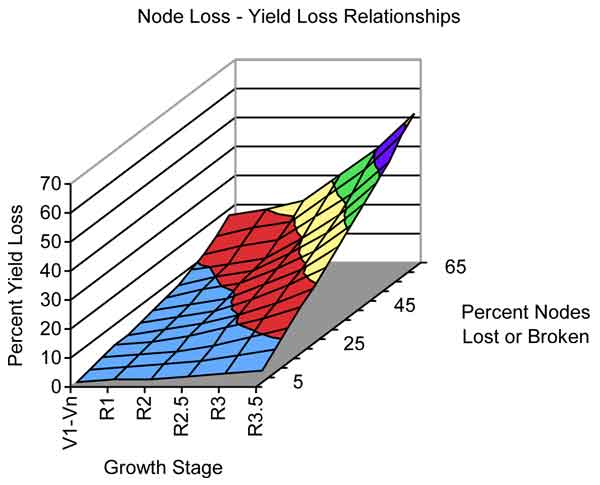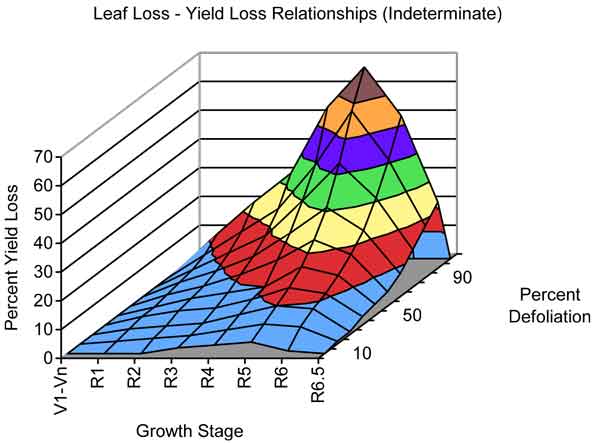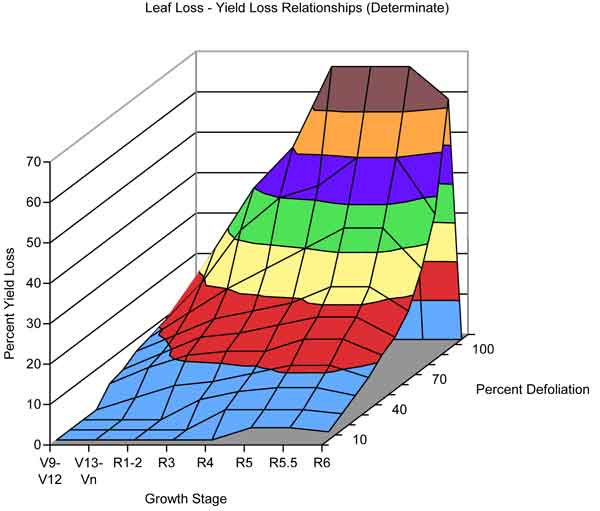Soybeans
Assessing hail damage on soybeans
Hailstorms can severely damage soybean plants and stands. This brings up several questions: Can the soybeans recover? How much potential yield loss may have occurred? Is it worth replanting some fields? The answers depend on the severity of the damage and the stage of growth at the time of the damage.
Assessing the effect of hail on soybeans is not a simple matter. The method of assessment depends on the stage of growth at the time of the hail and must incorporate estimates of node damage, leaf loss, and stand loss.
The figures below were generated from data used by the crop insurance industry to estimate potential yield loss from percent stand reduction at different original plant populations, percent of nodes cut off or broken, and percent leaf loss (Soybean Loss Adjustment Standards Handbook, USDA-FCIC-25440, 06-1999).
Vegetative growth (VE, VC, V1 to VN)
Damage to nodes and leaves
Soybeans can tolerate quite a bit of hail damage to nodes at early stages of growth. If the plants have a leaf or two remaining, or even just the cotyledon leaves, after a hailstorm, they can branch extensively from axillary buds and compensate quite well. In the vegetative stages, more than 50% of the nodes must be cut off or broken before resulting in yield reduction of more than 10%. Put another way, even if up to half the nodes are cut off or broken, yield loss will be only 10% or less- if the soybean has not flowered. Bruising is another factor to take into consideration, deep bruises can promote lodging issues.

Flowering and pod set (R1 to R6)
Damage to nodes and leaves: Indeterminate varieties will grow and flower over a 3 to 4 week period. As a result, soybean plants can recover fairly well from a hailstorm that causes significant loss of leaves, flowers, and early pods during the first 2 weeks or so of this period of flowering. Unless the weather is very hot and/or dry after the hailstorm, more flowers will form and set pods. If the hail occurs toward the end of that 4-week window, a significant loss of flowers and pods from hail damage can dramatically reduce yields. For indeterminate varieties at any level of leaf loss, yield losses are maximized when damage occurs at R5, and are less at earlier and later stages.

Loss of leaf area causes greater yield losses over more stages of development for determinate than for indeterminate varieties. The flowering period is shorter for determinate varieties, so they have less opportunity to compensate for loss flowers and pods. Yield losses of up to 10% can result from significant leaf loss in the later vegetative stages. Determinate varieties have 3% to 17% greater yield losses than indeterminate varieties from damage that occurs in the early reproductive stages (R2 to R3), depending on the extent of leaf loss. Yield losses are greatest from damage at R4 to R5.5.

Stand loss
If the hail breaks the stems of plants and causes plant death in the R1 to R6 reproductive stages of growth, the remaining plants will normally have only limited ability to branch out and compensate.
Pod fill through maturity (R6.5 and later)
Plants cannot compensate through either additional flowering or new branch development after R6.5. Therefore, the way to estimate yields at these stages is to make a direct seed count. Hail damage to leaves at these stages will have little or no effect on seed development or yields unless the leaves are knocked off the plant.
-Ignacio Ciampitti, Crop Production and Cropping Systems Specialist
-Kraig Roozeboom, Crop Production Agronomist